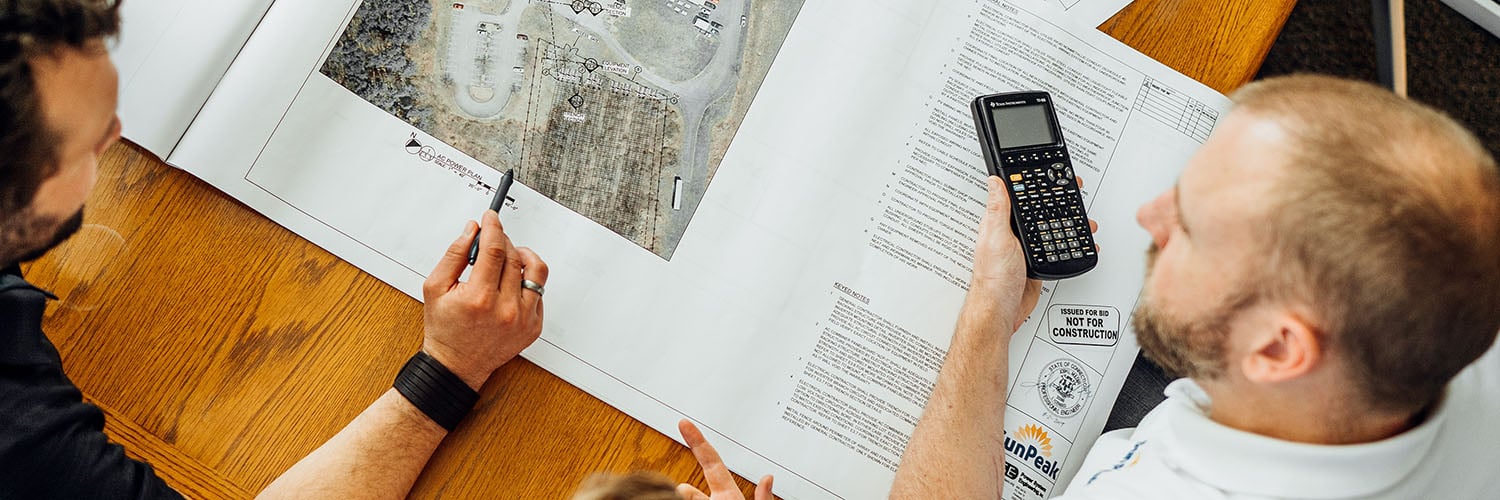Avoid common pitfalls when seeking commercial solar bids and get the best system for your business.
When your company makes a new asset purchase, it’s possible you’ll engage the help of an internal or external resource to conduct research and provide a purchase recommendation. Sometimes this process leads companies to decide on a specific plan, product, or other directive, which is then published as a formal Request for Proposal (RFP) so competitive bids can be sought and compared side by side.
When considering solar for your business, there are distinct times when this process can become overly and unnecessarily complicated, costly, and time consuming, and still may not reap the best result or financial return for your company. Based on successful engagements we’ve had over the years with hundreds of commercial customers as they explore and implement solar, we offer here some advice on getting a solar proposal – and ultimately a solar PV system - that meets your company objectives, minimizes hassles and headaches, and provides the greatest amount of trust in the investment.
Getting started: Avoid creating an overly specific initial plan
SunPeak often encounters a situation where a potential customer that is interested in solar has first hired an independent engineering firm, architect, or energy consulting firm to design a solar system for them. The resulting set of plans is then passed along to our team for cost estimating and final Engineering, Procurement, and Construction (EPC) services.
Commonly, the design firm that has been contracted is working on other aspects of a new building project for the customer beyond the solar system, so trust has also been established, and there is comfort in having an existing partner design the project and provide guidance on a solar fulfillment solution. Understandably, for some customers it seems logical to have an established solar design in hand to help normalize competing bids on the same project, thus enabling an easier “apples-to-apples” comparison of different solar providers.
While there’s perceived efficiency in this method, beware that creating a project design with specific products, layouts and performance criteria without the participation of the final EPC provider may not produce an optimal system nor best utilize your company resources.
Consider an example. SunPeak was recently awarded a large solar project for a multinational company. When SunPeak was first engaged on the project, the system plans had already been largely specified by the customer via an independent solar design firm that had no prior working relationship with SunPeak. Prior to being awarded the project, SunPeak’s project development team asked if it could consult with the customer on the final system design as our team immediately identified major areas for improvement. The customer agreed to this, and we engaged in the project expecting modifications to what was originally specified.
Over the course of several months and meetings, our team learned what really mattered to the customer and was able to offer insight and different design options that would better suit the customer’s goals, budget, and site characteristics. In the end, the customer allowed SunPeak to completely revamp the solar system design, essentially redoing all the work completed by the independent solar designer. This work was necessary because the original design lacked consideration for important and evolving codes, it specified materials that were no longer in production, and it did not account for recent supply chain challenges and various federal import tariff considerations. Also, because the original designer did not have solar installation experience, the design lacked important construction, monitoring, and maintenance considerations.
Though the project was ultimately very successful and the revised design proved to be a great fit for the project site, the customer would have saved time and energy by starting with more of a “blank sheet” approach, allowing SunPeak team members to bring their expertise to the design table right from the start.
To summarize, here are the top customer drawbacks to over-specifying initial solar project requirements before engaging with your solar EPC provider:
1. Specialized solar expertise is not captured.
At SunPeak, we’ve been working closely with clients, and engineering and installing solar systems for nearly a decade and have completed hundreds of successful commercial and industrial (C&I) solar projects. It’s what we do, all the time, every day. In doing so, we’ve developed a rich base of experience that is nuanced and constantly evolving. When a generalist is brought in to do the design work in place of a specialist, that deep understanding and insight is missed, and the project plan often suffers as a result.
2. A preset design may include unfamiliar or inferior components or methods.
From engineering to procurement and through installation, allowing the solar provider to work with system architectures and components that are familiar and have proven field quality allows maximum workflow efficiency and the most successful outcome. Conversely, unfamiliar components and designs can increase the chances of error, installation mistakes, and long-term performance issues.
3. Procurement efficiencies may be sacrificed.
SunPeak has several “best-in-class” suppliers for each of the important building blocks that go into a solar system.
Moreover, SunPeak also maintains a considerable amount of ready-to-use inventory within our standard architecture, a considerable advantage to customers when considering the potential for supply chain delays and overall project costs.
4. Possible performance monitoring incompatibility.
When the solar system is installed, a selected monitoring platform will be chosen to provide the customer with long-term performance data and validation. This data is also utilized by the system’s operations & maintenance (O&M) provider for ongoing assessment of the system’s health or need for service. SunPeak installs a common monitoring platform across all its systems, so our customers’ systems are compatible with hundreds of other projects we monitor daily. If a different monitoring platform is specified and installed, these efficiencies are lost and reduced attention to a performance issue can result.
5. Work is often repeated or redone.
As the above example illustrates, if the system needs to be re-engineered by the final solar provider, it leads to time and financial waste. This doesn’t help anyone, and ultimately the customer can end up paying more for some or all the system’s design work.
6. The overall project can be more costly.
The inability to leverage an established supply chain, the need to train field personnel on unfamiliar equipment, and the potential need to re-engineer work all adds to additional project cost and inefficiency.

Best practices: Approaching the solar project proposal process confidently
Here are a few tips as your business prepares to go solar:
1. Define what your end goals are, not how the goals will be achieved.
For instance, stating “We have a goal to offset at least 1/3 of our annual electrical consumption using a high-quality solar system that will be warrantied and maintained by the solar provider for a minimum of 25 years” is better than stating “We are seeking a turnkey bid on a 117 kWdc system that utilizes 360x 325 Wp Hanwha Q Cells, two 50 kWac Core1 SMA inverters and PanelClaw racking.” By being flexible with the details, you allow the company you are seeking a quotation from to understand your goals and bring its best solution to the table.
2. Engage with potential solar providers early in the process.
There really is no point that is too early to engage with a solar provider, even if the project is a year or more away. Your building may not be complete, or even designed yet, but developing early-stage relationships with potential providers and allowing them to provide guidance on the front-end can save a tremendous amount of time, cost, and potential rework down the line. At SunPeak, we provide early-stage project engineering consultation and discussion at zero cost to build the relationship early and add value. By doing that, we develop and earn customer trust and can get a project pointed in the right direction right out of the gate.
3. Be receptive and flexible to various ways to fulfill a given project.
Often, there are multiple pathways to success. We commonly provide more than one approach to the same set of criteria, explaining any tradeoffs to each design. We will execute on the option that you decide is best for your circumstances, organizational plans, and budget.
4. Find a company you can trust, and then trust them.
We would encourage you to survey several potential solar partners initially. Get a feel for their experience base, what they stand for, and their track record for success. Once you establish that, let the solar provider do what they do best, which should be listening to your end goals and then designing and constructing a system, incorporating quality components they are familiar with and that will satisfy all the project requirements. Along the way, they should also help you understand the available solar incentives and financing options that can help you maximize the ROI of the system, especially if financial return is a primary project motivation.
Key Takeaways
We understand that solar can be confusing to those who are not familiar with it, and that’s why we’re here to help. At any stage of a project, whether it be very early-stage feasibility all the way through to “we need to get something done right now, but haven’t thought about it yet,” reach out to SunPeak's project development team and we’ll be able to help you navigate to the best possible solution. And, if you’ve found yourself in a position where you’ve already invested time and energy into a system design but it doesn’t feel right for your goals, then don’t hesitate to contact us. By providing us some flexibility, we’ll be in the best position to assist as we’ll have the full spectrum of design, procurement, and installation variables available to optimize your result.

